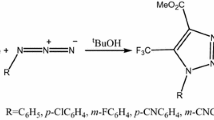Abstract
Density functional theory calculations have been performed at B3LYP/6–31+G (d) level to quantify the aromaticities of mono- to triazines through dyotropic double hydrogen transfer (DDHT) reaction. The reaction was chosen such that the azines are products of double hydrogen dyotropic rearrangement, and activation barriers and energies of the reactions were functions of the aromaticities of azines. Small activation barriers and high energies of reactions were characteristic of the reactions delivering highly aromatic azines. Synchronicity, reaction energies and energies of activation have been analyzed, and the aromaticity values obtained thereof were compared with the aromaticity values from other geometric and magnetic criteria. Energies of activation were found superior to the energies of reaction for the determination of the aromaticities. Aromaticities of most of the azines were comparable to the aromaticity of benzene. Activation barriers and reaction energies for the dyotropic reactions delivering contiguous or polynitrogeneous azines had thermodynamic contributions arising from the contiguous nature of azines, in addition to the aromaticity related thermodynamic contributions. Moreover, the aromaticity values of azines are also affected by the fusion of azine to the reaction center. When corrected for these factors, the aromaticities of azines using energies of activation for DDHT correlated nicely with the aromaticities of azines reported in the literature through NICS (0) πzz and some other energetic methods.

Azines have aromaticities comparable to benzene.




Similar content being viewed by others
References
Kekulé A (1865) Bull la Soc Chim Paris 3:98–110
Schleyer PR (2001) Chem Rev 101:1115–1118
Binsch G, Heilbronner E (1968) Tetrahedron 24:1215–1223
Labarre JF, Crasnier F (1971) Top Curr Chem 24:33
Binsch G (1973) Naturwissenschaften 60:369–374
Balaban AT, Oniciu DC, Katritzky AR (2004) Chem Rev 104:2777
Krygowski TM, Cyranski MK, Czarnocki Z et al (2000) Tetrahedron 56:1783–1796
Minkin VI, Glukhovtsev MN, BY S (1994) Aromaticity and antiaromaticity: electronic and structural aspects.
Schleyer PR, Maerker C, Dransfeld A et al (1996) J Am Chem Soc 118:6317–6318
Schleyer PR, Jiao H, Goldfuss B, Freeman PK (2003) Angew Chem Int Ed 34:337–340
Schaad LJ, Hess BA (2001) Chem Rev 101:1465–1476
Katritzky AR, Jug K, Oniciu DC (2001) Chem Rev 101:1421–1450
Dewar MJS, Gleicher GJ (1965) J Am Chem Soc 87:692–696
Dewar MJS, De Llano C (1969) J Am Chem Soc 91:789–795
Dewar MJS, Gleicher GJ (1965) J Am Chem Soc 87:685–692
Dewar MJS, Gleicher GJ (1966) J Chem Phys 44:759
Hess BA, Schaad LJ, Holyoke CW (1975) Tetrahedron 31:295–298
Schaad LJ, Hess BA Jr (1974) J Chem Educ 51:640
Randic M (1977) No title. J Am Chem Soc 99:444–450
Hess BA, Schaad LJ (1973) No title. J Am Chem Soc 95:3907–3912
Hess BA Jr, Schaad LJ (1971) No title. J Am Chem Soc 93:2413–2416
Hess BA Jr, Schaad LJ (1971) No title. J Org Chem 36:3418–3423
Schaad LJ, Hess BA Jr (1972) No title. J Am Chem Soc 94:3068–3074
Hess BA Jr, Schaad LJ (1971) J Am Chem Soc 93:305–310
Hess B, Schaad LJ, Holyoke CW (1972) Tetrahedron 28:3657–3667
Schleyer PR, Pühlhofer F (2002) Org Lett 4:2873–2876
Gutman I, Milun M, Trinajstić N (1975) Comm Math Comput Chem 1:171–175
Aihara J (1976) J Am Chem Soc 98:2750–2758
Gutman I, Milun M, Trinajstic N (1977) J Am Chem Soc 99:1692–1704
Frenking G, Cossío FP, Sierra MA, Fernández I (2007) Eur J Org Chem 5410–5415
Fernández I, Cossío FP, Sierra MA (2009) Chem Rev 109:6687–711
Fernández I, Frenking G (2007) Faraday Discuss 135:403
Kiener A (2003) Angew Chem Int Ed 31:774–775
Counotte‐Potman A, Van Der Plas HC (1981) J Heterocycl Chem 18:123–127
Eicher T (1998) J Prakt Chem 340:487–488
Wiberg KB, Nakaji D, Breneman CM (1989) J Am Chem Soc 111:4178–4190
Bird CW (1996) Tetrahedron 52:9945–9952
Bird CW (1997) Tetrahedron 53:13111–13118
Bird CW (1992) Tetrahedron 48:335–340
Mandado M, Otero N, Mosquera RA (2006) Tetrahedron 62:12204–12210
Mandado M, González‐Moa MJ, Mosquera RA (2007) J Comput Chem 28:127–136
Solà M, Feixas F, Jiménez-Halla JOC et al (2010) Symmetry (Basel) 2:1156–1179
Feixas F, Matito E, Poater J, Solà M (2008) J Comput Chem 29:1543–1554
Raczyńska ED, Hallman M, Kolczyńska K, Stępniewski TM (2010) Symmetry (Basel) 2:1485–1509
Wang Y, Wu JIC, Li Q, Schleyer PR (2010) Org Lett 12:1320–1323
Fallah-Bagher-Shaidaei H, Wannere CS, Corminboeuf C et al (2006) Org Lett 8:863–866
Frisch MJ, Trucks GW, Schlegel HB, et al. (2009) Gaussian 09 Revision C. 01, Gaussian Inc. Wallingford CT
Specowius V, Bendrath F, Winterberg M et al (2012) Adv Synth Catal 354:1163–1169
Iaroshenko VO, Ostrovskyi D, Ayub K et al (2013) Adv Synth Catal 355:576–588
Salman GA, Nisa RU, Iaroshenko VO et al (2012) Org Biomol Chem 10:9464–9473
Ullah H, Shah A-HA, Ayub K, Bilal S (2013) J Phys Chem C 117:4069–4078
Javed I, Khurshid A, Arshad MN, Wang Y (2014) New J Chem 38:752–761
Lecea B, Arrieta A, Lopez X et al (1995) J Am Chem Soc 117:12314–12321
Mitchell RH (2001) Chem Rev 101:1301–1315
Herradon B, Alonso M (2010) J Comput Chem 31:917–928
Acknowledgments
K.A. acknowledges the Higher Education Commission (HEC) of Pakistan (Grant No.20-1899/R & D/10/8863-), COMSATS Institute of Information Technology and King Faisal University for financial support to the project. R.L acknowledges the support to this work by the project “Light2Hydrogen” of the BMBF and the project “Nano4Hydrogen” of the ESF and the state of Mecklenburg-Vorpommern.
Author information
Authors and Affiliations
Corresponding author
Electronic supplementary material
Below is the link to the electronic supplementary material.
ESM 1
(DOC 155 kb)
Rights and permissions
About this article
Cite this article
Maria, Hanif, M., Mahmood, T. et al. Aromaticity of azines through dyotropic double hydrogen transfer reaction. J Mol Model 20, 2304 (2014). https://doi.org/10.1007/s00894-014-2304-7
Received:
Accepted:
Published:
DOI: https://doi.org/10.1007/s00894-014-2304-7




